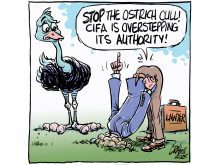Health Canada’s plan to put warnings on ground beef and pork makes little sense and can’t be logically explained to Canadians.
In a few months the nation’s most trusted food advisor intends to place front-of-package warnings on some of the most popular, safe and affordable foods Canadians can consume: ground beef and ground pork.
Paradoxically, Health Canada included those two foods in its two-year-old Food Guide as part of a healthy diet.
The agency’s intentions may be good. It wants to protect children from foods high in saturated fats. But the effect is to place a warning label on two forms of ground meat. However, the labels won’t be affixed to packages of meat before it is ground. It’s as though a grinder turns meat into a new and threatening source of protein.
Read Also

Budget seen as fairly solid, but worrying cracks appear
The reaction from the agriculture industry to prime minister Mark Carney’s first budget handed down November 4th has been largely positive.
Health Canada has indicated there will be exemptions to its labels on saturated fats. If it comes from a farmers’ market, that’s exempt. If it isn’t sold directly to a consumer, exempt. If it is raw, unground meat, fish or poultry, that too is exempt. There are other foods that, for practical reasons, are exempt. Even extremely well-marbled beef or juicy pork loins with a large fatty layer are exempt. Dairy products will not carry the warning labels either.
It doesn’t make sense.
Dairy products contain significant amounts of saturated fats — in theory, just as much or more than ground beef and pork. Despite any rumours to the contrary, dairy products come from livestock and contain fats similar to those found in ground meat.
Health Canada came down on dairy products in its own food guide, but not this time.
No, this time dairy products are exempt, just as ground beef and pork should be. The agency has some explaining to do.
Few Canadians consume raw ground meats. Typically, they are cooked to Health Canada’s own guidelines of 160 F (71 C). By the time they reach that temperature, a lot of the fats have left the meat, making food labelling even less appropriate and harder to justify.
Meat is expensive and many Canadians have said some of it is unaffordable in the current economic climate. But ground meats are generally the affordable among the meat choices. Health Canada nonetheless appears to be targeting them, discouraging consumers from purchasing nutritious food options.
If Health Canada is to remain a trusted source of information about how to live a healthier life, it needs to consider all its messages and their practicality for the people it serves. Warning labels about safe products could easily be misinterpreted by consumers, driving them away from affordable, safe, Canadian-produced foods.
The more cynical among us might even think the organization is using the labelling process as an excuse to promote a meat-free diet, or at least one with a smaller meat ration. That is something Health Canada does endorse, though it seems unlikely the organization is using the ground meat front-of-package labelling warnings to move the nation in that direction.
But it’s possible.
Whatever the rationale behind labelling recommendations and plans, the science must be good and the messaging consistent. They must serve the interests of Canadian health and wellbeing.
Making Canadians scared of healthy meats and fats should not be on the nation’s menu.
Karen Briere, Bruce Dyck, Barb Glen and Mike Raine collaborate in the writing of Western Producer editorials.















